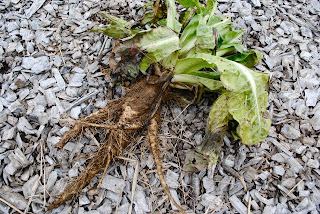
It's winter. At least it seems that way sometimes. Today it's nearing 42 F. and drizzling, with strong gusts from the South. Yesterday I stood near the egg mobile in a raking light that revealed the whims of our flock. They were scripted in lines across the snow, a visual record of their humble habits - a quick jaunt to a mound of high grass, a pause to peck at the impression left by a footstep, a new path home to the feeder.
This same light gave evidence of others' whereabouts. Of course we are cognizant of the mice in our house. How could we not be? They are louder than we are most days. 'Vermin Supreme' is what we've taken to calling the cadre upstairs. Apparently they approach our door in nearly the same way we do.

While the mice ferret away in our walls, and the chickens find satisfaction around life's edges, thoughts of our garden take up firm residence in my mind. This is where I last saw it.
 (This photo is no small testament to the biodegradability of pants, by the way. I pulled this skeleton from the goat manure compost that came with the farm. David, who was diligently laboring away with us in the Fall, held them up for the photo once they'd been unearthed. Incredible. My fears of everlasting cast-offs are crumbling.)
(This photo is no small testament to the biodegradability of pants, by the way. I pulled this skeleton from the goat manure compost that came with the farm. David, who was diligently laboring away with us in the Fall, held them up for the photo once they'd been unearthed. Incredible. My fears of everlasting cast-offs are crumbling.)SEEDS! Garth and I spent hours with a few catalogues this week and the lists we compiled from our last growing season. What did well? What did poorly? What did we want more of? Less? What's new? I have to give an enthusiastic round of applause to FEDCO-SEEDS. We have ordered our seeds primarily from Johnny's in the past. Don't get me wrong. They are great - proven seeds with fantastic turn around and customer service. We even ordered a number of things from them this year, but they don't encourage the whimsy gardener with their expensive small packets. Their seeds become very competitively priced once you buy 5000 or more of them, but we want to experiment in our garden. We have no idea how a new vegetable will turn out, or if we'll like them once they do, and paying a lot for a small number of seeds is not super fun. FedCo, by comparison, was perfect for us. They offer a number of open-pollinated seeds and they sell their packets cheaply. They write very informative reviews for each variety they offer (my best impersonation of their style - 'This heirloom beet was first made public by Jim Carnville (made up name) of Iowa in 1824. It outperformed Detroit Dark Red in last years growing trial, bulking up quickly, and and the taste, though milder than Bull's Blood, was the favorite in the 2011 Taste the Harvest competition in Maine. It stores well and doesn't get tough if you let it mature late into the season...' you get the gist). They offer FREE SHIPPING (shipping is often a large proportion of the cost of ordering seeds), and they give 10% off orders greater than $100. Man are they good! That said, we haven't seen how their seeds grow yet, but we'll keep you posted.
Lastly, I want to add a special thank you to Jane Ireland. She lives nearby and called me up after reading through the entirety of our blog. After consulting with her sister, who is also an avid gardener, she recommended we grow a strong smelling heirloom marigold. She told me that flea beetles (the bane of this gardener in Spring) follow their noses to our plants. Planting marigolds around the garden and amid the beds will disrupt them enough to give our plants a leg up in the world. We ordered two kinds, and I am thrilled to have the advice of someone whose fought similar battles organically in this area. Thanks Jane!
-Alanna








